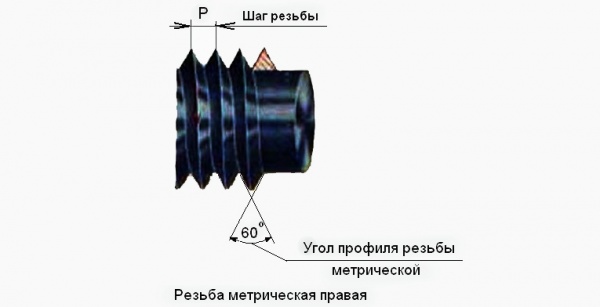From internal pipelines, drains are transported by external ...


Inch thread is used to create turns only in metal pipes. Also, inch threads are used in the manufacturing process of collapsible fittings made of metal and plastic.
The presented threaded connection has its own standardization with reference to GOST 6357-81, which regulates such thread parameters as pitch and diameter.
The dimensions that the threaded connections will have depend on the distance between the oppositely placed upper points located at the end of the pipe.
Pipe thread and its dimensions will directly depend on the value of the inner or outer diameter of the product. Currently, there are such types of threads as:
In addition, various types of threads have their own designation. So, for example, the left-hand thread designation is marked with the letters LH. For more detailed information, a threaded connection is indicated in the drawings by additional letters, where:
Thread metric as well as inch has a standard diameter from 1 to 180 mm. Speaking about the differences between these two types, it is worth noting that they are in the form of a profile of a round crest.
The inch profile visually looks sharper. This is due to the angle of the upper “original triangle”, which is 55 °.

Also pipe thread metric differs from inch calculation of values \u200b\u200bof step and diameter. This is due to the fact that metric turns are created with orientation in millimeters.
The pipe inch is 3.33 cm. In both cases, the pitch parameter of the pipe turns is measured not in millimeters, but in threads.
The thread here is the exact number of grooves that are available on a 1 inch pipe section. So, for example, standard water mains have a thread designation in only two versions - 11 threads (metric pitch of 2.31 mm) and 14 threads (metric pitch of 1.8 mm).
Trapezoidal thread is used in the manufacture of all kinds of screws. These include lead screws for cutting machines, screws of hydraulic presses, lifting devices and worm gears.
Such turns are significantly different from other types visually - they are made in the form of an isosceles trapezoid. The value of the profile angle in this case can be equal to 15, 24, 30, and 40 °.
When determining such significant characteristics, a tool such as:
In some cases, the function of the gauge may be performed by a coupling or fitting with internal or external coils applied in advance, which correspond to predefined parameters.
When performing the step measurement, a bolt is used, if significant resistance arises when screwing into the turns, they are redone.
In the event that the process occurs without difficulty and the bolt is tightly placed in the pipe, the step is considered to be performed correctly.
When re-creating the turns, the process proceeds with the orientation to create a larger caliber. Using a thread gauge is quite simple. It is equipped with measuring plates that are inserted into threaded connections that are not yet docked.
The plates resemble small files, and if, when applied to the turns, the profile of the plates coincides with the turns cut on the inner or outer surface, then they correspond to the set value.
This value is indicated on the tool plate. Using a caliper, only the indicator of the outer diameter of the turns can be measured; the micrometer also performs the same function. Experts recommend taking measurements with the most suitable instruments for this - calibers.
Both metric and tubular (inch) analogs of turns can be created both on the internal and external surfaces.
This is carried out using two methods: mechanical and manual. When implementing the manual method, such devices as swordsmen and dies are used.
The tap can create internal coils, and the die can create external coils. The process begins with the fact that the product is firmly fixed in a vice, and the swordsman is inserted into the gate.
When using the die, the function of the vortock is performed by the die holder. After that, the die is put on the product, and when using a tap, it is inserted straight into the hole in the pipe.
If necessary, then all actions are repeated once more, while gradually turns will be created in the body of the product, at that depth, which will be equal to the height of the profile.
The inner and outer turns are not cut simultaneously, but in a sequential order. However, in most cases surfaces with only external or internal grooves are created.
The creation of turns mechanically involves the use of a special cutter, which is attached to the support of the machine.
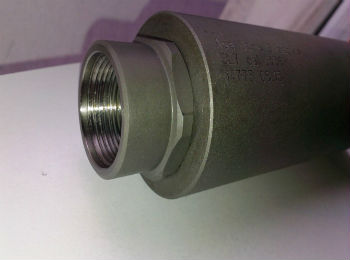
Before starting work, the support moves to the workpiece paradise, after which the height of the profile is set using the feed of the transverse type.
With the mechanical method, a screw die can also be used - a tool with plates having a comb profile.
Using the installed head, you can create 2-5 sizes of external grooves. After the plates are installed in the die head, the pipe is clamped in a vice or using a wrench.
The end face of the product is cut at a right angle. After starting the tool, the head creates grooves on the part at the moment of rotation.
Threads according to the system of measures are divided into metric and inch. Metric and inch threads are used in threaded connections and screw gears. Threaded connections are called detachable connections made using threaded fasteners - bolts, screws, nuts, studs or threads directly applied to the parts to be joined.
It has the shape of an equilateral triangle in the profile with an apex angle of 60 °. The tops of the protrusions of the mating screw and nut are cut off. Characterized by a metric thread with a screw diameter in millimeters and a thread pitch in millimeters. Metric threads are performed in large and small steps. For the main thread with a large pitch. Small threads are used for adjustment, for screwing thin-walled, as well as dynamically loaded parts. A metric thread with a large pitch is indicated by the letter M and a number expressing the nominal diameter in millimeters, for example M20. For fine metric threads, an additional step is indicated, for example, M20x1.5.
Fig. 1 metric thread
The inch thread (Fig. 2) has the same appearance in the profile as the metric thread, but it has an angle at the apex of 55 ° (Whitworth thread is the British standard BSW (Ww) and BSF), the angle at the apex is 60 ° (American standard UNC and UNF). The outside diameter of a thread is measured in inches (1 "\u003d 25.4 mm) - dashes (") indicate an inch. This thread is characterized by the number of threads per inch. Inch American thread is made with large (UNC) and small (UNF) pitch.
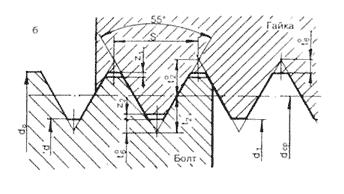
Fig. 2 inch thread
Fastener size chart for American inch UNC large-pitch thread (60 degree profile angle)
| Inch size | Size in mm | Thread Pitch |
| UNC No. 1 | 1.854 | 64 |
| UNC No. 2 | 2.184 | 56 |
| UNC No. 3 | 2.515 | 48 |
| UNC No. 4 | 2.845 | 40 |
| UNC No. 5 | 3.175 | 40 |
| UNC No. 6 | 3.505 | 32 |
| UNC No. 8 | 4.166 | 32 |
| UNC No. 10 | 4.826 | 24 |
| UNC No. 12 | 5.486 | 24 |
| UNC 1/4 | 6.35 | 20 |
| UNC 5/16 | 7.938 | 18 |
| UNC 3/8 | 9.525 | 16 |
| UNC 7/16 | 11.11 | 14 |
| UNC 1/2 | 12.7 | 13 |
| UNC 9/16 | 14.29 | 12 |
| UNC 5/8 | 15.88 | 11 |
| UNC 3/4 | 19.05 | 10 |
| UNC 7/8 | 22.23 | 9 |
| UNC 1 " | 25.4 | 8 |
| UNC 1 1/8 | 28.58 | 7 |
| UNC 1 1/4 | 31.75 | 7 |
| UNC 1 1/2 | 34.93 | 6 |
| UNC 1 3/8 | 38.1 | 6 |
| UNC 1 3/4 | 44.45 | 5 |
| UNC 2 " | 50.8 | 4 1/2 |
The thread can be internal and external.
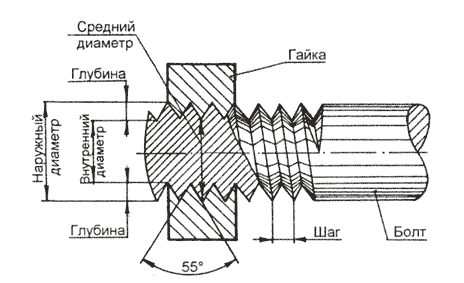
Fig. 3 Thread Elements
The main elements of the threads are shown in Fig. 3 These include the following elements:
More about inch fasteners:
In engineering, three systems of threads are adopted: metric, inch and pipe.
Metric thread (Fig. 145, a) has a triangular profile at an apex of 60 °.
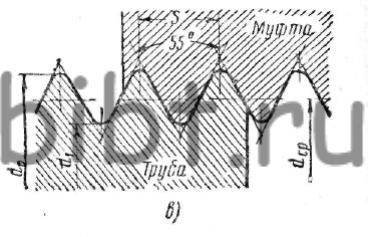
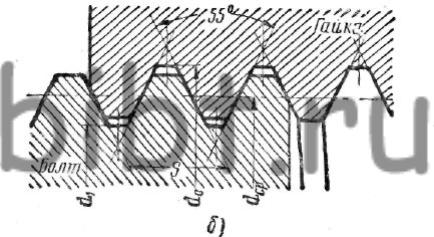
Fig. 145. Thread systems: a - metric, b - inch, c - pipe
There are six types of metric threads: main and small -1; 2; 3; 4th and 5th. Small threads differ in pitch with a given diameter, expressed in millimeters. Metric threads are denoted by the letter M and numbers characterizing the dimension of the outer diameter and pitch. For example, M42X4.5 denotes a metric base with an outer diameter of 42 mm and a pitch of 4.5 mm.
Fine thread, in addition, in the designation has a number indicating the thread number, for example 2M20X1.75 - the second metric fine, outer diameter 20 mm, pitch 1.75 mm.
Inch thread (Fig. 145, b) has an angle of 55 ° at the apex. Inch thread is cut in the manufacture of spare parts for machines with inch cuts and should not be cut on new products. Inch threads are characterized by the number of threads per inch (1 ") of length. Outer diameter inch thread measured in inches.
Pipe thread(Fig. 145, c) it is measured in the same way as the inch in inches and is characterized by the number of thread threads per 1 ". The thread profile has an angle of 55 °. For a pipe thread, the diameter of the pipe hole is conventionally taken as the diameter on which its outer surface is cut thread.
The tops of the protrusions of the screw and nut with pipe thread are made with flat or rounded sections.
A flat-cut profile is easier to manufacture and is used for threads of ordinary pipe joints. Pipe thread is designated: 1/4 "PIPE; 1/2" PIPE. etc. (tab. 25).
Table 25 Designation of threads in the drawings
| Type of thread | Legend | Designation Elements | Example of thread designation for bolt and nut |
Metric |
M | Outer diameter of thread (mm) or outer diameter and pitch (mm) | M64 or M64X6 or 64x6 |
Metric small |
1M | 1M 64X4 or 64X4 | |
| 2M | 2M 64X3 or 64X3 | ||
| 3m | 3M 64X2 or 64X2 | ||
| 4M | 4M 64X1.5 or 64X1.5 | ||
| 5M | 5M 64X1 or 64X1 | ||
Trapezoidal |
LADDER | Outer diameter and thread pitch (mm) | LADDER. 22x5 |
| UP | UP 70X10 | ||
Inch with profile angle 55 ° |
Nominal thread diameter in inches | 1" | |
Tubular cylindrical |
PIPE. PR * PIPE. KR ** | Thread designation in inches | 3/4 "PIPE. OL 3/4" PIPE. KR |
Conical tube |
PIPE. CONIC. | 3/4 "PIPE. |
* Profile with plane-cut vertices (straight line). ** Profile rounded.
Threads are right and left; according to the number of visits - one-, two-, three-start and multi-start.
In order to determine the number of thread starts, just look at the end of the screw or nut and count how many ends of turns are on it.
As a rule, all fasteners (bolts, screws, screws, etc.) have a single thread.
Which are indicated in inches. Many buyers may not pay attention to this, and therefore there is a possibility of acquiring a pipe with a size that does not match the required. The reason for this is that the inch on the surface of the pipe), as the name implies, is measured in inches. In this case, one inch is 25.4 millimeters. This value differs from the accepted millimeter standards, which can greatly complicate the choice of the necessary part.
An inch cylindrical thread provides for displaying the pipe dimensions in inches, while it is indicated in fractions of this unit of measurement (due to its small size).
Due to the discrepancy between the millimeter and the inch, in practice a significant difference appears between the dimensions of the thread on the pipe. This is because Western standards say: an inch thread refers to an internal thread. The differences between a metric inch and the so-called pipe inch should be taken into account.
For example, the pipe indicates that the inch thread has a size of ½. Thus, you get a pipe with an outer diameter of 20.95 mm, instead of the expected 12.7 mm. Consequently, pipe inch It turns out equal to 33.249 mm and consists of the size of the passage itself and the double wall thickness.
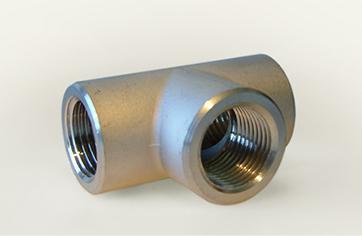
This example shows that the use of this indicator is more acceptable, since such a system best describes the size that an inch thread has.
Now that the notation has become clear, we can proceed to the classification and purpose of this parameter.
The cylindrical inch thread for the purpose and nature of the work carried out is divided into:
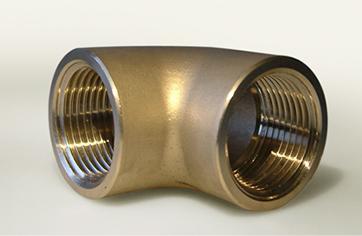
Often available with a profile having an angle of 60 °. All values, whether it is a thread pitch or an outer diameter, are indicated in millimeters.
By the size of the step, one main and 5 types of auxiliary thread are distinguished (it is also called shallow). It should be noted that such a thread is considered more durable than coarse (with absolutely equal outer diameters). The undoubted advantage of small threads can also be called a small angle of elevation of the helix and, as a result, increased twisting resistance.
Threads of this type are used in the most loaded hollow parts, as well as in elements that are subject to strong shocks and shocks. The adjusting nuts also have a similar thread, since it allows for more precise adjustment.
In addition, inch thread can be performed at a rotation angle of 55 °. In this case, the diameter is still set in inches, but the thread pitch is determined by the number of threads per inch. A similar type is used in various parts for mechanical fixation of each other.
In our metric world, it is sometimes difficult to navigate other measurement systems. We sometimes wonder how Americans or British can use outdated measures of length, mass, area, etc. And they, in turn, do not understand us - living according to the laws of a single Measurement System. However, as in any rule, there are certain exceptions that are understandable to everyone - and residents of America, and Misty Albion, and Europe, and Russia. This article is devoted to a review of pipe and metric threads, a variety of which is often encountered in everyday life.
Threaded connections are very common in construction, engineering, mechanical engineering, the aerospace industry and in everyday life. What is a screw and nut, even children in kindergarten know, since classes with the designer can not do without these details. Despite the fact that the first screw was invented by Archimedes, and our ancient ancestors made extensive use of screw gears in presses for squeezing oil from olive seeds and sunflower seeds, as well as for lifting water for irrigation of fields, the idea of \u200b\u200bcreating a real screw connection was realized only in the 15th century, when one of the Swiss watchmakers for the first time managed to grind the first screw and nut using simple devices.
At the same time, the rational idea that the thread should be the same in all countries of the world did not come to humanity soon. So, widespread and familiar to everyone who has at least a little experience with technology, metric thread appeared and was described in the standards only after the introduction of a unified Measurement System based on the standards of meter, kilogram and second. So the appearance and wide distribution of metric carving dates from the end of the 19th century. Until that time, inch threads dominated the world.
The main difference between a metric thread and an inch thread is that all its parameters are tied to a millimeter, and an equilateral triangle is taken as the basis for the profile of the thread itself, since all its angular dimensions are the same and equal to 60 degrees. In the standardization of metric threaded connections, it is important that the nut and bolt match not only the angular dimensions of the thread, but also its diameter and pitch. Many, especially those who have cars, faced an incomprehensible phenomenon when the screw and nut have the same diameter, but it is impossible to screw the screw into the nut. This suggests that a thread with a smaller pitch is used in this place and in order for the screw to screw in without problems, its thread pitch should also be reduced.
The standards describing metric threads indicate that they must be marked with the letter M, and then the diameter of the thread and its pitch are indicated. The diameter range of metric threads ranges from one to six hundred millimeters. The spread of the thread pitch is from 0.075 to 3.5 mm. Small-pitch threads are used for measuring tools, medium-pitch threads for parts and assemblies loaded and operating under vibration conditions, and large-pitch threads are used for fastening heavy load-bearing structures.
When creating standards for metric threads, various tolerances were taken into account, which specify the degree of roundness of the outer edge of the thread and deviations from the profile so that the screw and nut can be freely tightened to the point of abutment by hand.
Although metric threads have not been widely used in sealed joints, such a possibility is laid down in the standards. So, the thread with the designation MK is used for self-sealing joints due to the taper of the external and internal threads. Moreover, for a tight connection, it is not necessary that the screw and nut are with a tapered thread. It is enough that this thread be threaded on a screw.
Cylindrical metric thread is quite rare. Its designation is MJ. The main difference is in the screw, which has an increased radius of the cavity on the thread, which gives the threaded connection based on a cylindrical metric thread higher heat-resistant and fatigue qualities. This thread is used in the aerospace industry. However, a regular metric screw can be screwed into a nut with such a thread.
Despite the predominance of right-handed threads in all devices and mechanisms, it is still necessary to use left-handed threads to implement certain functions. The metric left-hand thread is no different from the right-hand thread, except for the direction of rotation, which is opposite to the right-hand screws. If a regular screw is twisted clockwise, then the left one is unscrewed in the same direction.
Also, sometimes you can meet with multiple metric threads. It differs in that not one spiral, but two or even three are cut simultaneously on a bolt and nut. Multi-threading is often used in high-precision equipment, for example, in photographic equipment, to uniquely position the position of parts during mutual rotation. Such a thread can be distinguished from the usual one by two or three beginnings of turns at the end.
Despite the very widespread use of metric threads, in many developed countries of the world, so-called inch threads traditionally remain in greater use. A pipe thread is universally measured in inches. And, despite the strong differences between these types of threads, plumbers all over the world need to explain the differences between a half-inch pipe and a three-quarter pipe.
The difference between inch and metric threads is that the angle at the top of the thread is 55 degrees, the thread pitch is calculated as the ratio of the number of threads per inch of thread length. An inch is understood to mean a distance of 2.54 cm. Which initially corresponded to the length of the first phalanx of the human thumb, which is the same for almost all people.
Since the angle at the apex is different than in metric threads, it is not possible to combine metric and inch threads. In countries with a metric system, only inch inch threads are used, which are denoted by the letter G. The letter is followed by a fractional or whole denomination, which indicates not the size of the thread, but the conditional pipe clearance in inches or fractions of an inch. The peculiarity of the pipe thread is just the fact that it takes into account the thickness of the pipe walls, which can be thicker or thinner depending on the material of manufacture and the working pressure for which the pipes are designed. Therefore, the inch standard of pipe threads is understandable and accepted around the world as an exception to the metric rules.
In addition to a simple cylindrical pipe thread, there is a tapered pipe thread. It has the same characteristics as a regular pipe, with the exception of the taper, which allows you to create more tight joints. It is designated by the letter R for the external thread and Rc for the internal. Left-hand threads are additionally marked with the letters LH, followed by a numerical value in whole and fractional fractions of an inch.
For applications in other connections, except for plumbing, inch threads with a top angle of 60 degrees are used in the USA and Canada. There is a fairly wide range of these threads, which differ in the range of thread pitch and other characteristics. It is worth noting that some threads from the inch row coincide with metric, which in some cases can be on hand. For example, in photographic equipment, the diameter of the connecting thread by which the camera is attached to a tripod is the same throughout the world, regardless of the country of manufacture, since the characteristics of this thread are the same for metric and inch threads.
However, do not confuse the English inch industrial thread, which was approved back in 1841, and it was developed by Joseph Witworth himself. This thread almost repeats the pipe, as it has an angle at the apex of 55 degrees. Screws and nuts with this thread do not mate with inch fasteners from America and Canada.
